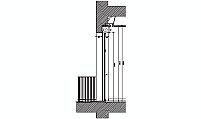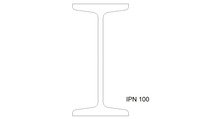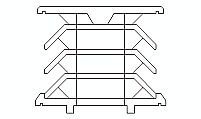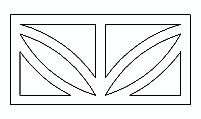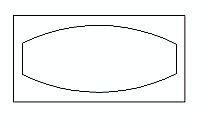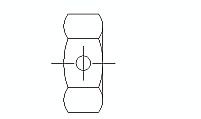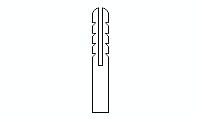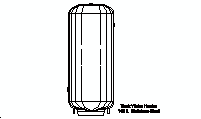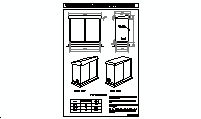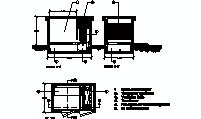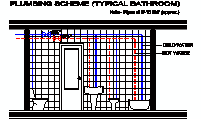CAD Blocks categories
 3D models
3D models home furniture
home furniture sanitary ware - bathrooms
sanitary ware - bathrooms professional equipment
professional equipment doors and windows
doors and windows people and animals
people and animals plants and trees
plants and trees vehicles - transports
vehicles - transports architectural details
architectural details mechanical - electrical
mechanical - electrical urban planning - civil works
urban planning - civil works safety health construction
safety health construction accessible design
accessible design drawing sheet
drawing sheet signals
signals construction machinery
construction machinery accessories and objects
accessories and objects maps and street maps
maps and street maps
Elegant Baluster Design in CAD Format

size: 5 kb
category: architectural details
related categories:
description: detailed ornamental baluster with intricate scrollwork, featuring symmetrical upper and lower sections connected by a circular central motif.
file extension: .dwg CAD - AutoCAD software
Detailed CAD Block of Elegant Baluster Design
Detailed Description of the Elegant Baluster Design
The elegant baluster design features a central circular motif flanked by symmetrical scrollwork. This design is divided into two sections: the upper and lower areas, both incorporating delicate curves that terminate in intricate scroll patterns. The symmetry and flow of the curves give this baluster a timeless aesthetic suitable for both traditional and modern applications. This design is often fabricated using wrought iron, which ensures both durability and elegance.
Alternative designs may include rectangular or flat profiles, or supports with integrated lighting systems for added functionality. These variants are often used in projects requiring specific architectural styles or additional features, adapting to both functional and visual needs. The variety of designs available ensures compatibility with diverse settings and enhances their versatility.
Common Dimensions of Elegant Baluster Designs
Common dimensions for balusters like this include a height of 36 inches (91.44 cm), with the circular central motif measuring approximately 6 inches (15.24 cm) in diameter. The scrollwork sections typically span a width of 8 inches (20.32 cm), providing balance and proportion to the overall design.
The baluster in this design has an upper and lower scroll pattern, each measuring 12 inches (30.48 cm) in height. These dimensions are carefully crafted to ensure structural integrity while maintaining the ornamental detailing, making it a focal point in any railing system.
Installation and Construction Tips
- How is this baluster installed?
- This baluster is typically welded or bolted onto a horizontal rail system for secure attachment and durability. Welding ensures a permanent and highly stable connection, ideal for long-term installations in high-traffic areas. Alternatively, bolting provides flexibility, allowing the baluster to be removed or replaced as needed. Installation should include precise measurements to maintain uniform spacing and alignment, ensuring both structural safety and visual harmony.
- What materials are commonly used?
- Wrought iron or steel is often used due to its strength and resistance to wear, making it ideal for outdoor or high-stress applications. Aluminum is a lightweight alternative, often used for easier handling and installation while still maintaining durability. Composite materials, which combine aesthetic flexibility with rust resistance, are increasingly popular for contemporary designs. The choice of material should consider both the functional demands and the visual style of the project.
- Can it be customized?
- Yes, this design can be customized by altering the scrollwork, adjusting the dimensions, or adding decorative elements such as additional motifs or colored finishes. Customization allows the baluster to blend seamlessly with specific architectural themes or personal design preferences. Techniques such as powder coating or hand painting can further enhance the visual appeal, adding unique textures or colors that align with the overall aesthetic.
- How do you maintain this baluster?
- Regular cleaning with mild soap and water is essential to remove dirt and prevent buildup, especially for outdoor installations. For metal balusters, applying a rust-resistant coating or wax periodically will protect against corrosion and prolong their lifespan. Inspecting for loose bolts or welds ensures that the structural integrity remains intact. Proper maintenance not only preserves the baluster's appearance but also ensures long-term safety and functionality.
- Can it be combined with other railing elements?
- Yes, this baluster pairs well with a variety of materials, including wood, glass, and metal. For instance, combining it with glass panels can create a modern and open aesthetic, while pairing it with wooden rails adds warmth and traditional charm. The use of contrasting materials or finishes, such as matte balusters with glossy rails, can enhance the visual interest and make the railing a focal point in the space.
Advantages of Elegant Baluster Designs
Elegant baluster designs provide a unique combination of aesthetic appeal and structural functionality. Their intricate details add a touch of sophistication to staircases, balconies, and terraces. The symmetrical patterns enhance the visual flow, making them ideal for enhancing the overall design of a building or space.
Compared to plain or minimalist balusters, these decorative designs stand out by offering a more ornate and artistic touch. They are versatile enough to be incorporated into both traditional and contemporary settings, increasing the value and appeal of architectural projects.
History and Evolution of Baluster Designs
The history of baluster designs dates back to ancient civilizations where stone and marble were primarily used for their construction. Over the centuries, materials such as wrought iron and wood became prevalent, allowing for more intricate and lightweight designs. This evolution enabled the creation of ornamental patterns that combined both artistic and functional elements.
In different parts of the world, unique variations exist, such as intricately carved wooden balusters in Asia or minimalist glass-and-metal combinations in modern architecture. These designs continue to evolve, incorporating new materials and manufacturing techniques to meet contemporary architectural demands.



